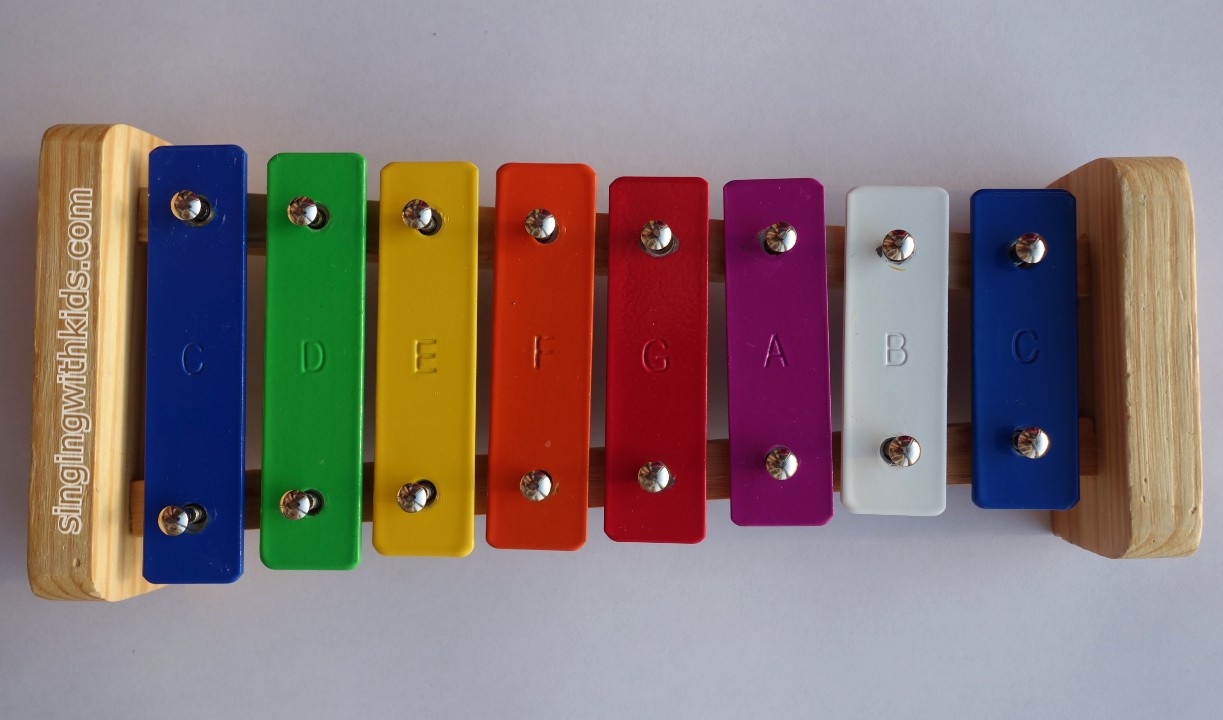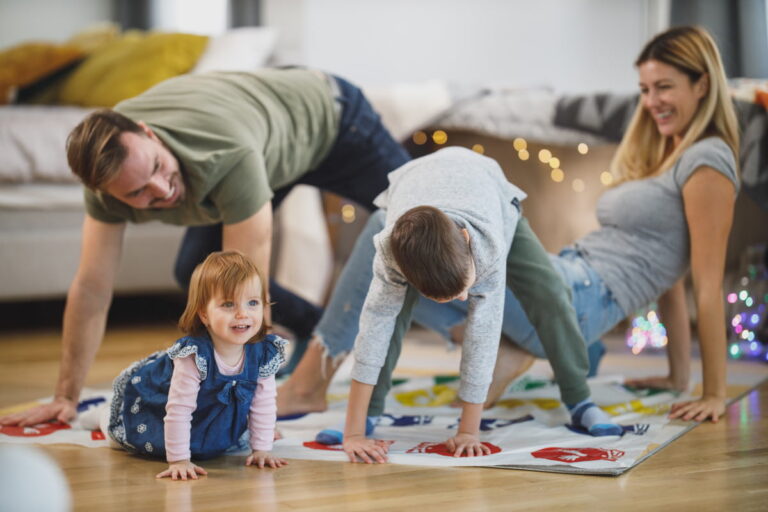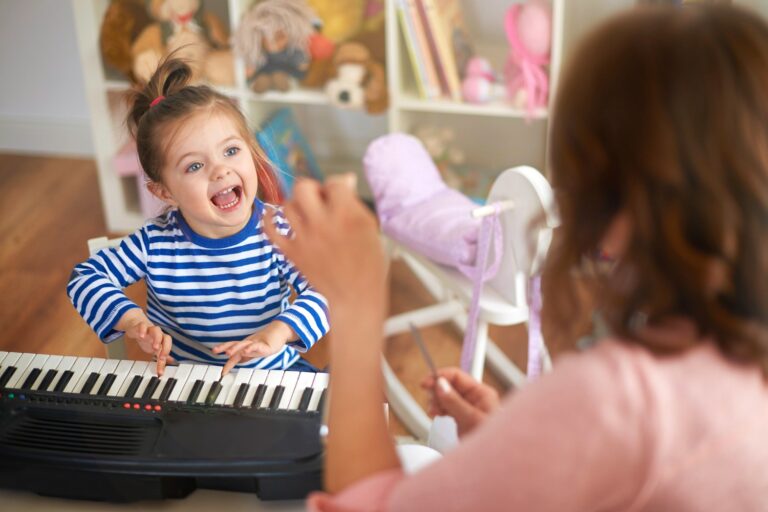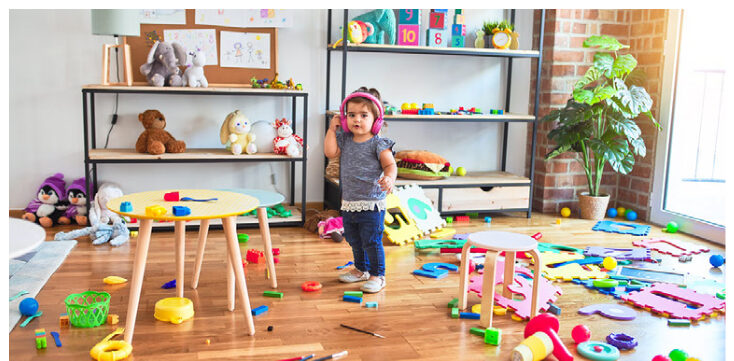Creative Ways to Introduce Music to Babies and Toddlers
One of my favorite memories as a new parent was the first time I sang a lullaby to my baby and saw those tiny eyes staring back at me, completely focused on the sound of my voice. There’s something magical about those early musical moments. Babies are natural explorers, and long before they can speak, they’re tuning into the sounds around them. They copy what they hear, from the gentle cooing of a parent to the playful bark of a dog. Noise-making is one of the very first steps toward making music!
There’s a reason rattles and bells are a huge hit with babies and toddlers. Give a baby a shaker, and watch the joy on their face as they realize they can create sound! Toddlers take it a step further—many will proudly arrange every pot and pan they can find in the kitchen and give an impromptu concert with a wooden spoon. To us, it might sound like clatter, but to them, it’s an exciting way to explore the world of music.
Introducing music to babies and toddlers isn’t about formal lessons. It’s about playful discovery. And the benefits? They’re lifelong. Early musical exposure helps build language skills, supports social and emotional development, and even strengthens the bond between parent and child. Plus, making music together brings pure joy—something we could all use a little more of.
Table of Contents
Singing Through Daily Routines
One of the simplest—and most powerful—ways to introduce music into your child’s life is by weaving songs into your daily routines. In our house, we have a song for everything, and I mean everything! These little melodies make transitions smoother, chores more fun, and quiet moments even more special.
Here are some of our favorites:
- Bedtime lullabies: Singing a soft lullaby at bedtime is a soothing way to wind down. We love classic songs like Twinkle, Twinkle, Little Star and Hush Little Baby. There are wonderful lullaby albums available too (check out our favorite collection of bedtime songs!).
- Bath songs: Bath time is perfect for singing silly songs. This is the Way We Wash Our Toes gets giggles every time. You can make up verses as you go—”This is the way we wash our ears,” and so on.
- Tidy Up songs: We sing a special cleanup song when it’s time to put toys away. It’s amazing how a cheerful tune can turn cleanup time into a game!
- Weather songs: Whether it’s raining, snowing, or sunny outside, we have a song to go along with it. On rainy days, we sing Rain, Rain, Go Away, and when the snow falls, we sing about snowflakes gently falling from the sky. These songs help children make connections with the world around them.
The beauty of having “a song for everything” is that it brings predictability and fun into your child’s day. It also helps little ones feel secure because they start to understand the rhythm of daily life.
Active Music-Making and Movement
Once you’ve woven singing into your daily rhythm, the next joyful step is active music-making! This is where you and your little one can really have fun exploring sound and movement together.
Babies and toddlers naturally love to move. Whether it’s clapping their hands, bouncing up and down, or swaying side to side, movement is part of how they experience the world. Music just gives them a wonderful reason to move more!
Some of our favorite ways to combine music and movement include:
- Action songs: Think If You’re Happy and You Know It, where you clap, stomp, and shout hooray! These songs encourage little ones to listen, respond, and express themselves with their bodies.
- Dancing around the room: Put on a favorite tune and have a dance party. It doesn’t have to be fancy. Just moving freely and having fun builds confidence and coordination.
- Adding simple instruments: Hand your toddler a shaker or tambourine while you sing or play music. They’ll love the chance to make their own sounds in time with the music. Percussion instruments like maracas, drums, rattles, triangles, and even pots and wooden spoons are always a big hit!
- DIY instruments: Get creative together by making your own instruments! Fill a clean, empty bottle with rice or beans to make a shaker. Glue ribbons to a wooden spoon for a dancing ribbon wand. Make a DIY microphone from a paper towel roll and aluminum foil—it’s a hit at our house!
These activities aren’t about teaching music perfectly. They’re about creating an environment where your child can experiment and explore. Gentle encouragement goes a long way. When little ones feel free to explore without pressure or correction, their natural curiosity leads the way.
And remember: ten minutes of focused, joyful music-making with your child is more impactful than forty minutes of distracted half-attention. So set everything else aside for a little while. Look into their eyes, smile, and join them in the fun!
DIY Instruments and Creative Exploration
Now that your child is enjoying singing and movement, it’s the perfect time to dive deeper into creative musical exploration with simple instruments you can make at home.
There’s something extra special about using homemade instruments. It gives little ones a sense of pride and ownership, and the process of making them can be just as fun as playing them!
Here are some easy and safe DIY instrument ideas we’ve tried and loved:
- Egg shakers: Fill plastic Easter eggs with rice, dried beans, or sand. Seal them tightly with glue or strong tape (we love using colorful washi tape for this!). Shake along to songs or make up your own rhythms.
- Rhythm sticks: Cut a wooden dowel into shorter lengths or use sturdy wooden spoons. Tap them together or on different surfaces to explore sounds.
- Ribbon wands: Attach ribbon scraps to a popsicle stick or wooden spoon. These make beautiful visuals for dancing to slow or fast songs.
- Sensory bottles: Fill clear plastic bottles with small objects like beads, buttons, or glitter mixed with water. Seal tightly. Toddlers love shaking them and watching the contents move.
- DIY microphone: Take a paper towel roll and wrap it in aluminum foil for a shiny “mic.” Kids love to hold it while they sing their favorite songs!
Making instruments together not only boosts creativity but also teaches basic cause and effect. When your toddler shakes a bottle and hears a sound, they start making connections about how their actions produce effects in the world.
Most importantly, resist the urge to correct how they use these instruments. Let them explore. Maybe they’ll tap a rhythm that surprises you! Gentle encouragement and curiosity go much further than trying to guide them “the right way.”
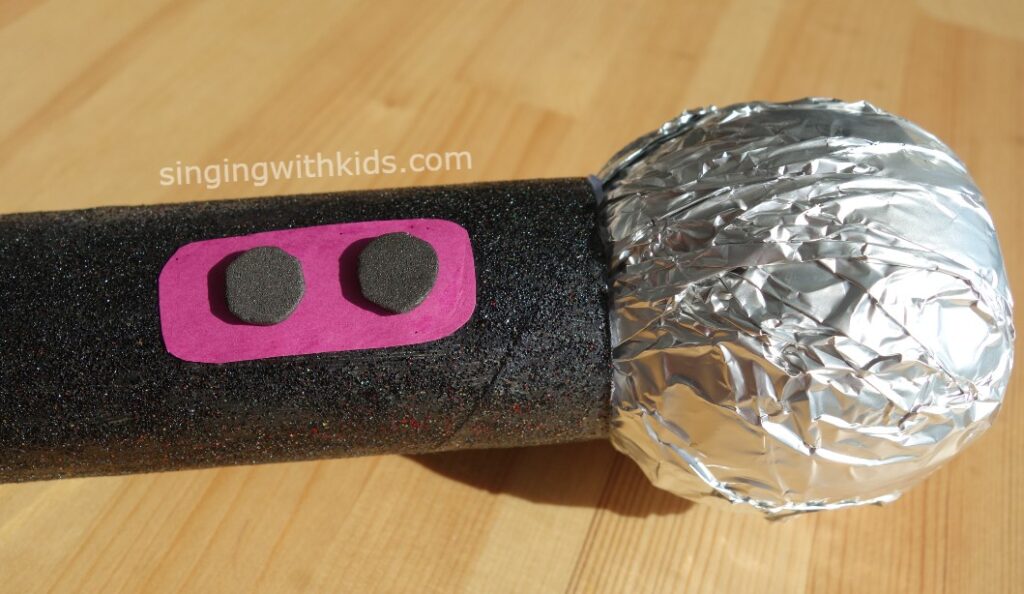
Creating Family Music Traditions
Music has an incredible power to bring people together, and building family traditions around music can create lasting memories that your children will cherish. In our home, music is woven into the fabric of our family life, and I hope it will be in yours too.
One of our favorite traditions is the “after-dinner concert.” After we finish our meal, we sometimes pull out the instruments and let the kids put on a little show. Sometimes it’s a wild and silly performance; sometimes it’s a quiet song with everyone singing along. What matters is that we are together and sharing music.
You can create your own traditions, big or small. Here are a few ideas to inspire you:
- Morning songs: Start the day with a family favorite tune while making breakfast.
- Sing-along car rides: Keep a playlist of family-friendly songs (check out our favorite road trip playlist) and have sing-alongs on the go.
- Friday dance party: Pick one evening a week for a family dance party in the living room.
- Holiday songs: Have special songs you sing together for birthdays, holidays, or any family celebrations.
These traditions can become beloved rituals your child looks forward to and remembers for years to come.
The Importance of Parental Presence During Musical Activities
It’s easy to feel pulled in many directions as a parent. There’s laundry to fold, meals to prep, and a never-ending to-do list. But one of the most powerful things you can give your child—especially during music time—is your full, undivided attention.
Even just ten minutes of truly being present while making music together can have an enormous impact. Sit down, look your child in the eyes, and sing, clap, or play along with them. Put the phone down, turn off distractions, and be fully in the moment.
I’ve found that these little pockets of focused time create stronger connections and more joyful memories than anything else. And your child will notice. They’ll feel valued, heard, and loved.
Daily Exposure to Diverse Musical Experiences
Exposure is everything when it comes to building a lifelong love for music. Babies and toddlers thrive on hearing a wide variety of sounds, styles, and rhythms—and there’s no reason to limit them to cartoon tunes or baby-only songs.
In our home, we play everything from classical music and jazz to folk songs and world music. One afternoon, we’ll be listening to Vivaldi’s Four Seasons; the next day, it’s toe-tapping Irish fiddle tunes. Don’t be afraid to mix it up!
Here’s how you can introduce diverse musical experiences:
- Daily listening sessions: Spend time each day listening to different types of music. You can find curated playlists (check out our favorite kids’ music playlist) or simply explore genres on your own.
- Watch live performances (even on screen): Babies are fascinated by watching musicians play instruments. Find videos of orchestras, jazz bands, or choirs performing.
- Pretend to be conductors: Play classical pieces and encourage your child to “conduct” the music. My toddlers love waving a wooden spoon in the air and pretending they’re leading the orchestra!
- Move to the music: Encourage movement that matches the sound—stomping during loud drum music or twirling with soft melodies. Later on, you can gently introduce how different music can evoke different emotions.
Daily exposure like this lays a strong musical foundation and sparks a curiosity that can last a lifetime.

Taking Babies and Toddlers to Live Music Performances
One of the best ways to show children the magic of music is by experiencing it live. There’s something about watching musicians play their instruments in person, seeing the bows move across strings, the fingers dance on piano keys, and the energy of a live performance that makes music come alive for little ones.
You might be surprised how much babies and toddlers enjoy live performances. Yes, even small children can sit through—and enjoy—a concert if they are rested, fed, and in a good mood!
Here are some tips for making your first live music experiences positive:
- Start small and local: Look for family-friendly events at local parks, community centers, or children’s concerts. Many symphonies offer “petting zoo” events where kids can try out different instruments.
- Arrive early and sit near an exit: This gives you the option to step out for a break if your little one gets restless.
- Bring quiet snacks (if allowed): Opt for soft snacks that don’t crinkle. Think bananas or soft crackers rather than crinkly packages.
- Discuss concert manners: Talk to your child about respecting the musicians by sitting quietly and listening. Praise them afterward for their good behavior.
- Model respectful behavior: If they see you quietly enjoying the music, they’ll be more likely to follow your lead.
One of our favorite family outings was to a local outdoor jazz concert. We brought a blanket, some snacks, and just sat together, tapping along to the rhythm. My toddler swayed and danced, and my baby fell asleep to the soothing sounds of the saxophone. It was magical.
And don’t forget to show support for musicians! If you enjoy a street performer or local band, pause to listen and drop a tip. It teaches your children to appreciate and value live music.
Using Simple Instruments to Explore Musical Concepts
Musical instruments aren’t just fun—they’re a great way to help children understand musical concepts like pitch, rhythm, and dynamics in a hands-on way.
Here are some simple ideas to get started:
- Percussion instruments: These are great for teaching rhythm. Encourage your child to tap to the beat of a favorite song using a drum, tambourine, or even a pot and spoon.
- Xylophones: Show them how to make high and low sounds by striking the different bars. Explore simple melodies and encourage them to experiment with the notes.
- Keyboards: Demonstrate how the keys can create both high and low pitches. Start with simple tunes, and encourage your child to press one key at a time and try singing the same note back. Over time, they may enjoy copying short melodies!
- Volume play: Play loud and soft sounds and talk about what they hear. For example, say, “Let’s play this softly like a whisper,” or “Let’s play it loudly like a lion’s roar!”
- Tempo games: Speed up and slow down while clapping or playing an instrument. You can say, “Let’s go faster!” and watch how they respond with excitement.
As they grow, these playful games lay the foundation for understanding musical patterns and structure. And, of course, it’s fun to watch them figure it out their own way!
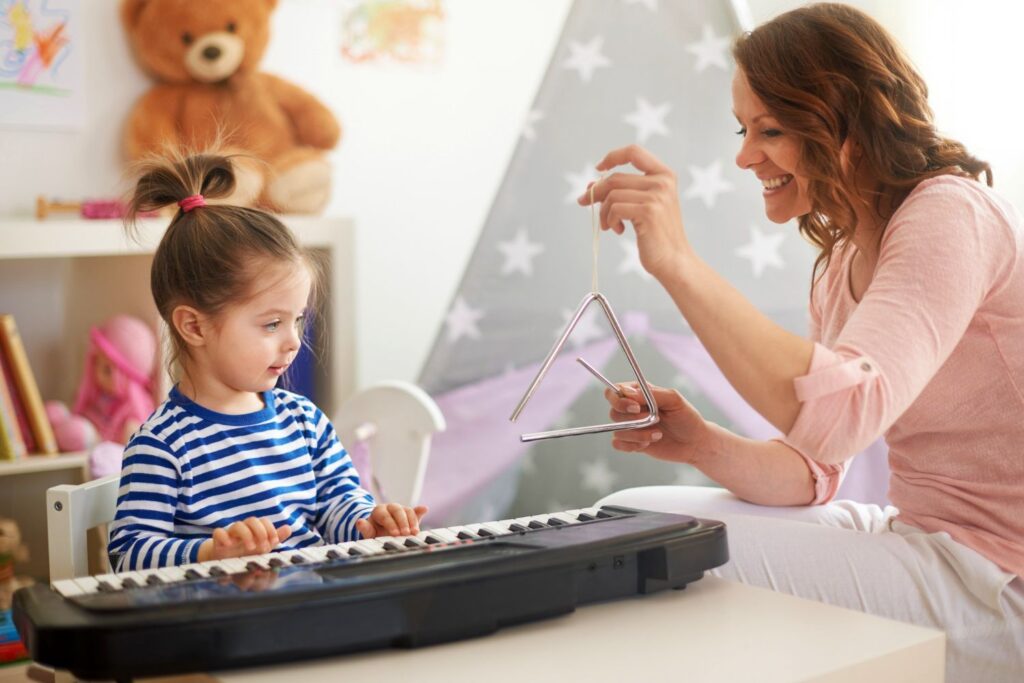
Teaching Respect and Appreciation for Music
One of the most important lessons we can teach our children is to respect music and the people who create it. Whether it’s learning to sit quietly during a concert or clapping at the end of a performance, these small moments of respect foster a deeper appreciation for music.
Here are a few ways we practice this in our home:
- Listening time: When we listen to music, we focus on it together—no phones, no distractions.
- Applause practice: We clap after a song finishes, even at home. It’s a simple way to teach kids how to show appreciation.
- Support local musicians: Stop to listen to street performers or attend local recitals. Talk about tipping musicians if it’s appropriate.
- Talk about the experience: After a concert, ask your child what they liked or how the music made them feel. It deepens their connection to what they heard.
Ensuring a Positive Musical Experience
It’s important to choose the right time for music activities. A tired, hungry, or overstimulated child isn’t going to have a great time making music. Instead, aim for moments when your child is rested, fed, and in a playful mood.
- Keep it short and sweet: Especially with younger babies, 5-10 minutes of music play can be more effective and enjoyable than trying to stretch it out.
- Watch for cues: If they seem overstimulated or fussy, pause and try again later.
- Follow their lead: Some days, your child might want to bang on a drum for ten minutes. Other days, they might prefer a quiet lullaby. Both are valuable musical experiences!
Creating a joyful, pressure-free environment helps nurture a lasting love for music. And that’s what it’s all about—making music a happy part of their world.
Making music with your baby or toddler is one of the most joyful and rewarding ways to bond. Whether you’re singing lullabies, dancing in the living room, or tapping along to a favorite song, you’re building memories and skills that will last a lifetime.
I hope these ideas have inspired you to bring more music into your family’s everyday life. If you have your own favorite music traditions or songs, I’d love to hear about them! Share your story in the comments or tag us on social media.
And if you found this guide helpful, please share it with fellow parents, friends, or family. Let’s spread the joy of music to as many little ears as we can!

